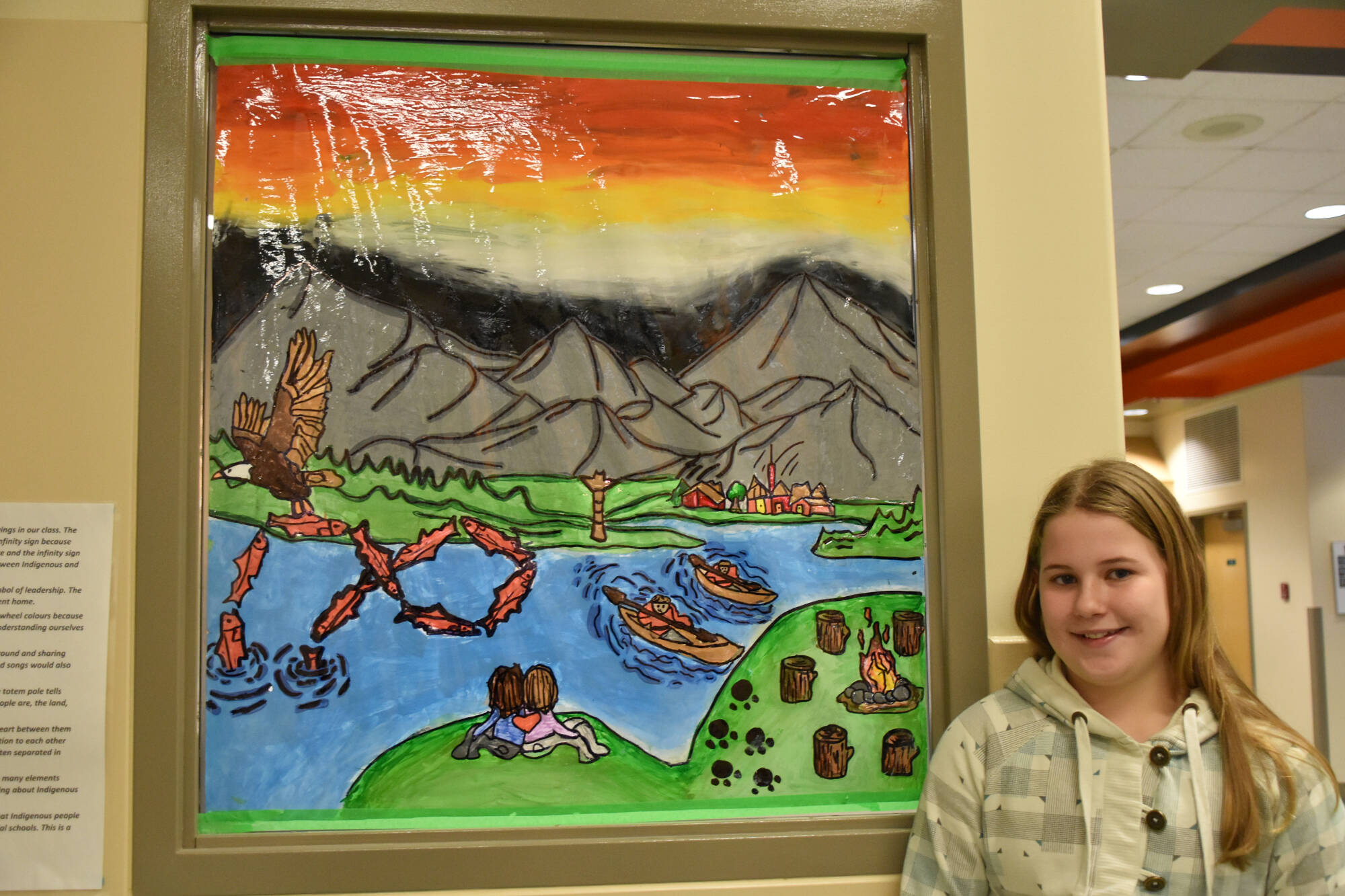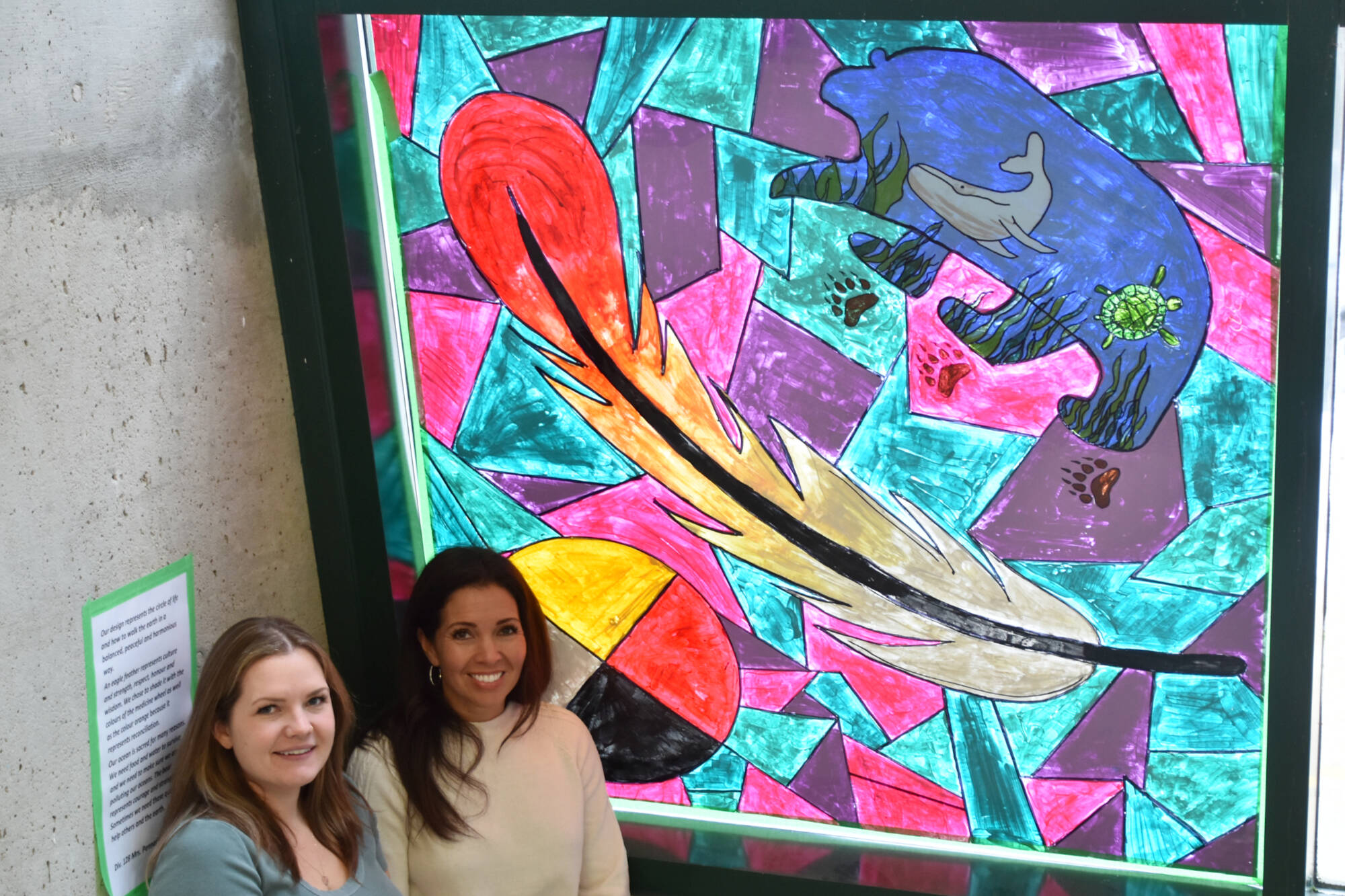Along with bringing in light, the windows at Shuswap Middle School are serving as a canvas for striking artwork that sheds light on what reconciliation can mean.
More than 30 large pieces of collaborative ‘stained glass’ art grace windows throughout the school, each piece accompanied by artists’ statements explaining the thinking behind the pictures.
The idea for the big project was born nearly three months ago by Indigenous support workers Theresa Johnson and Kaeli Hawrys. It was inspired by the stained glass window on Parliament Hill in Ottawa that commemorates residential school survivors.
“We thought, what are we going to do this year that connects kids’ understanding of traditional ways of life to what they know about residential schools and that experience, but also what their hopes are for the future and reconciliation,” explained Johnson.
To stir thinking about reconciliation, when they visited each classroom as the first step in the project, Johnson used the example of a cell phone. Her example was to point out why it’s important, for proper reconciliation, to move beyond acknowledgement.
She spoke about taking someone’s cell phone and keeping it indefinitely. Yet anytime anyone mentions that you have the other person’s phone, you acknowledge that, yes, it is their phone.
She said if no one speaks up, there’s nothing to stop the behaviour.
Moving beyond acknowledgement might look like: “I recognize I took your phone under false pretenses. I recognize that you thought you were just giving it to me to demonstrate a lesson, but in fact I took it, I made it my own, I wracked up some long-distance charges, I used all your data. I deleted your apps and I put some of my own photos on there.
“I’m sorry for doing that, I’m never going to do that again. I want to help you restore it, I’m going to compensate you for the bills you had to pay because I had it and I was using it. I’m sorry and it’s not going to happen again.”
Read more: Reconciliation project at Salmon Arm school catches elder’s eye
Read more: Video: New faces to emerge from the forest in Salmon Arm’s Little Mountain Park
Students said they’d heard the term ‘acknowledgment’ used a lot in terms of land, at events such as school assemblies and community gatherings.
During the process of the project, each student was asked to come up with a concept focused on what they knew about traditional Indigenous life, what they understood about residential schools or what their hopes were for the future. Their picture could also tell a story.
Then the individual concepts were presented to their classmates, so they could learn from each other, and each class could collaborate on the piece they would create for the window. For inspiration, Hawrys and Johnson read the students stories from The Elders are Watching, a collaboration between David Bouchard, a non-Indigenous poet and Roy Henry Vickers, an Indigenous artist.
Each creation displayed at the school takes a unique approach.

One painting was of a single tree from Mme. Wocknitz’ class. The artists’ statement, one of hope, said the tree represents severed relationships and the full tree represents the family union. A portion of it reads:
“The falling leaves represent our ancestors always being around us.
“It is possible for things to regrow. New trees can grow off of older ones. Things like family connections and relationships of trust and comfort can be restored.
“In the same way nature can be destroyed, there is also a way to preserve it. We can do this for people too.”
“How profound is that?” commented Johnson.
She said if students don’t feel a connection to why she and Hawrys are doing what they’re doing, then the learning doesn’t happen. Their hope is that students take the collective knowledge and classroom learning and extend it to a personal connection.
“We have all had situational experiences where something has happened to us that was never corrected through acts of reconciliation. Through a visual representation, students have been invited to explore how we can take action to improve upon our understanding and create change for the better.”
Hawrys said they want to leave the project up all year round because it’s important to have visual representation of Indigenous culture throughout the school.
Both are impressed with the students’ pieces and how touching some are.
“Their creations have been insightful and touching,” Johnson said. “Sometimes children are the greatest teachers. Many of their artist statements are inclusive and reflective of the broader community beyond SMS. Their artwork and perspectives have been inspiring and humbling.”
Read more: Orange Shirt Day: Salmon Arm students connect through the land
Read more: Indigenous history in Shuswap recognized with unveiling of first Trailhead post
martha.wickett@saobserver.net
Like us on Facebook and follow us on Twitter and subscribe to our daily newsletter.

